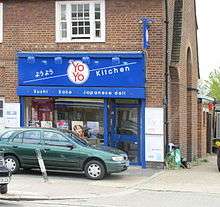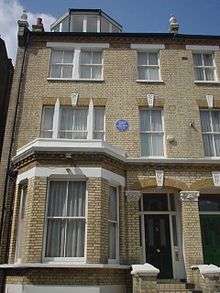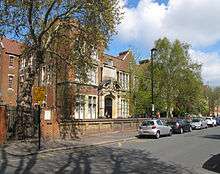Japanese community of London
| Part of a series on |
| Ethnic groups in London |
|---|
|
|
|
|
London includes a Japanese community.
History
Japanese people have been visiting and living in London since the 1860s: the Chōshū Five were students who attended University College London while it was still illegal to leave Japan.
Geography
Junko Sakai (酒井 順子 Sakai Junko),[1] author of Japanese Bankers in the City of London: Language, Culture and Identity in the Japanese Diaspora, stated that there is no particular location for the Japanese community in London, but that the families of Japanese "company men" have a tendency of living in North London and West London.[2] In 1991, according to The Economist, lower-ranked Japanese workers tended to live in Croydon. The newspaper stated that Japanese middle managers had a tendency to live in Ealing, Finchley, and Golders Green. The Economist added that bosses of the Japanese offices lived in Hampstead and St John's Wood.[3] Concentrations of Japanese residents support a greater density of Japanese restaurants and shops.[2]
The City of London has many Japanese insurance companies, banks, and security houses, and along with the Japanese businesses the City of London includes Japanese job agencies, interpretation and translation companies, and restaurants. Sakai states that the City of London is "perhaps" the "most important centre" of the London Japanese community.[2]
Commerce
The Yaohan Plaza in northwest London was originally an all-Japanese shopping centre planned in the early 1990s, when the Japanese economy was projected to expand.[4] The shopping centre opened in 1993 and included a Japanese supermarket.[2] The plaza had a bussing scheme intended to take Japanese from various parts of London to the mall. The mall was sold to a Malaysian company in 1999, its name was changed to Oriental City, and it became a pan-East Asian "Oriental" mall.[4] The centre closed in June 2008 after all tenants inside the shopping centre were given notice to leave due to the buyout of the building by a property developer.
Sogo once operated an outlet on Piccadilly Circus but it closed in the wake of the recession in the Japanese business community and the Japanese economy.[2]
The Piccadilly Circus area includes Japanese bookstores, food shops, restaurants, and travel service offices. Some Regent Street English shops installed Japanese shop assistants in order to better assist Japanese customers.[2] In the early 1990s, London had eight Japanese food shops and over 60 Japanese restaurants.[3]
Education
Sakai stated that most Japanese children in London attend either the Japanese School in London or local schools, and that the Japanese school, serves as one of the "geographical centres" of the London Japanese community.[2] The Japanese school was once located in Camden, which is now occupied by North Bridge House School,[5] in inner North London, but later moved to Acton.[4] The Japanese Saturday School in London (ロンドン補習授業校 Rondon Hoshū Jugyō Kō), a Japanese supplementary school, is a part of the institution.[6]
In 2003 several state primary schools developed support programmes for Japanese children. Some Japanese students in London attending secondary school go to other international schools, including The American School in London. In 2003 Paul White, author of "The Japanese in London: From transience to settlement?", wrote that "even company movers do not necessarily put their children through the Japanese schooling system in London".[4]
Sakai noted in her book that some Japanese families sent their children to British boarding schools and, in the case of university students, to "Oxbridge" (University of Oxford and University of Cambridge), in order to, as stated by Sakai, "give their children the 'best' education in Britain."[7]
Lifestyle

Company welfare systems give employees houses described by Sakai as "comfortable", and Sakai stated that the Japanese company men and their families "enjoy luxurious lives compared to Japanese settlers".[2]
Japanese children often attend English lessons and wives of Japanese employees often do flower arranging. Companies pay double the salaries to employees sent abroad and provide housing, so there is a perception that their lives are more comfortable in London than back home.[8]
Institutions
A Japanese Embassy is located in London.
The main organisation for the Japanese in London is the Japan Club.[8]
Notable residents

- Natsume Sōseki
- Tōgō Heihachirō did his work experience at Samuda Brothers, Isle of Dogs
See also
- Ethnic groups in London
- Japanese community in the United Kingdom
- Japanese Village, Knightsbridge
- Anglo-Japanese Alliance
References
- Sakai, Junko. Japanese Bankers in the City of London: Language, Culture and Identity in the Japanese Diaspora (Routledge Studies in Memory and Narrative). Routledge, October 12, 2012. ISBN 1134645082, 9781134645084.
- White, Paul. "The Japanese in London: From transience to settlement?" In: Goodman, Roger, Ceri Peach, Ayumi Takenaka, and Paul White (editors). Global Japan: The Experience of Japan's New Immigrant and Overseas Communities. Routledge, June 27, 2005. ISBN 1134431457, 9781134431458.
- Alternate version of the same book: Goodman, Roger, Ceri Peach, Ayumi Takenaka, and Paul White (editors). Global Japan: The Experience of Japan's New Immigrant and Overseas Communities. Routledge, May 1, 2003. ISBN 0203986784, 9780203986783. See Google Books entry
Notes
- ↑ "教員一覧" (Archive). Ferris University. Retrieved on 11 May 2015. "酒井順子 イギリス社会史"
- 1 2 3 4 5 6 7 8 Sakai, Page unstated (PT67). "Although the Japanese have no precise geographical location for their community, they are connected with each other personally, and one of their geographical centres is the Japanese school in London, previously in North London and now in West Acton."
- 1 2 "Britain: Japanese Spoken Here." The Economist. 14 September 1991. Volume 320, Issue 7724, p. 67. ISSN 0013-0613. CODEN ECSTA3. Accession number 00541106, 00898348. Available on ProQuest, Document ID 224204538. "Once here, they look for a location that reflects their position in the social pecking-order: Around London it is St John's Wood and Hampstead for bosses; Finchley, Golders Green and Ealing for middle managers; Croydon for lower ranks." and "London has more than 60 Japanese restaurants and eight Japanese food shops to stave off the torments of English food."
- 1 2 3 4 White, p. 89.
- ↑ "Which School?" Truman & Knightley Educational Trust, 1989. p. D-66 (See search page). "THE JAPANESE SCHOOL I Gloucester Avenue, London, NWI Tel (01) 485 0700 Head H Fujino Type Co-educational Day 9-14 No of pupils 536 Fees On application NORTH BRIDGE HOUSE JUNIOR SCHOOL I Gloucester Avenue, London,"
- ↑ "欧州の補習授業校一覧(平成25年4月15日現在)" (Archive). Ministry of Education, Culture, Sports, Science and Technology (MEXT). Retrieved on May 10, 2014.
- ↑ Sakai, pages unstated PT67-PT68
- 1 2 Sakai, pages unstated PT68
Further reading
- Pernille Rudlin, The History of the Mitsubishi Corporation in London: 1915 to Present Day. Routledge, London, 2000.
External links
| Wikimedia Commons has media related to Japanese community of London. |
- The Japan Society
- Japan Association in the UK (英国日本人会)
- (Japanese) Nippon Club (日本クラブ)
